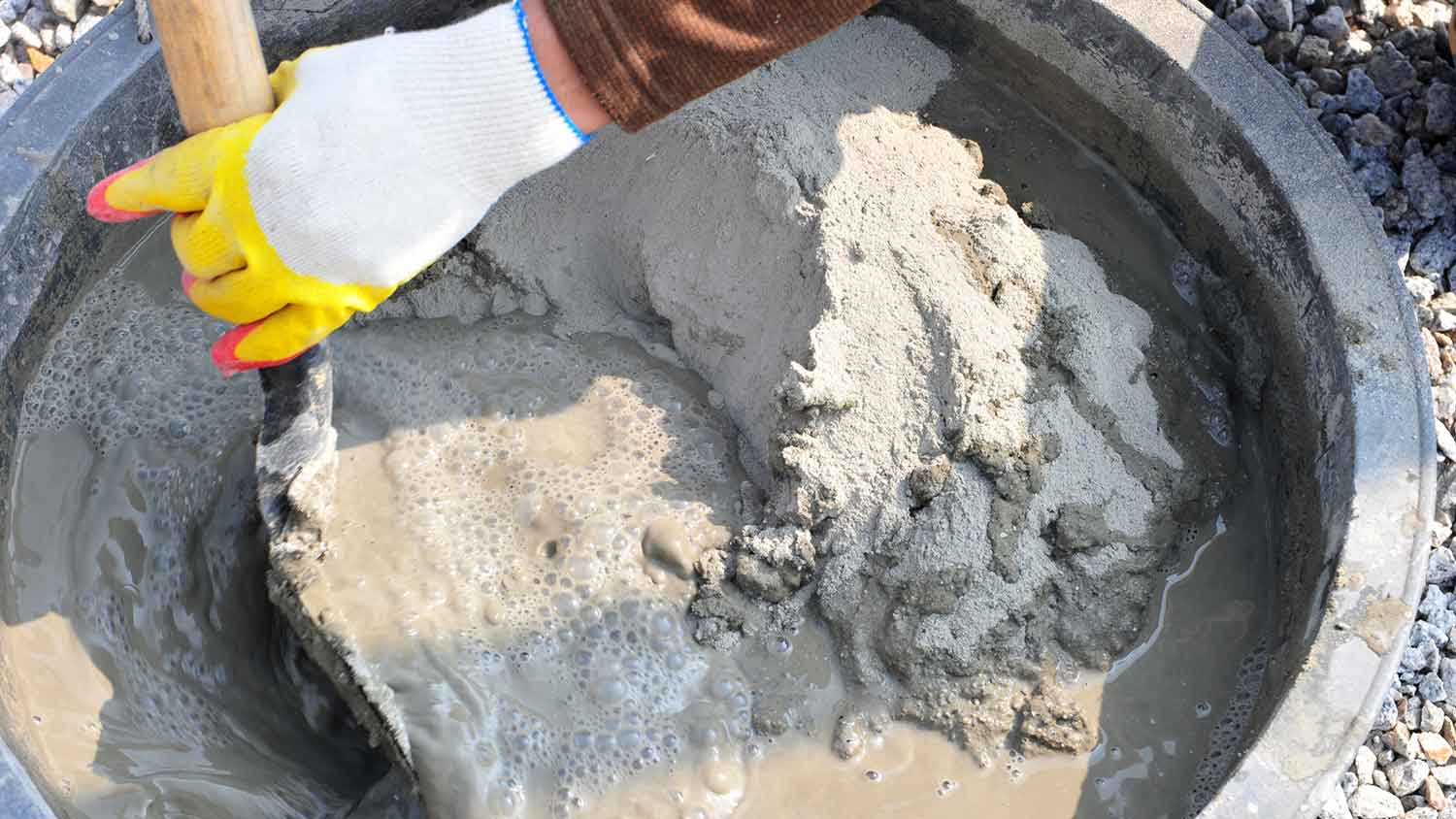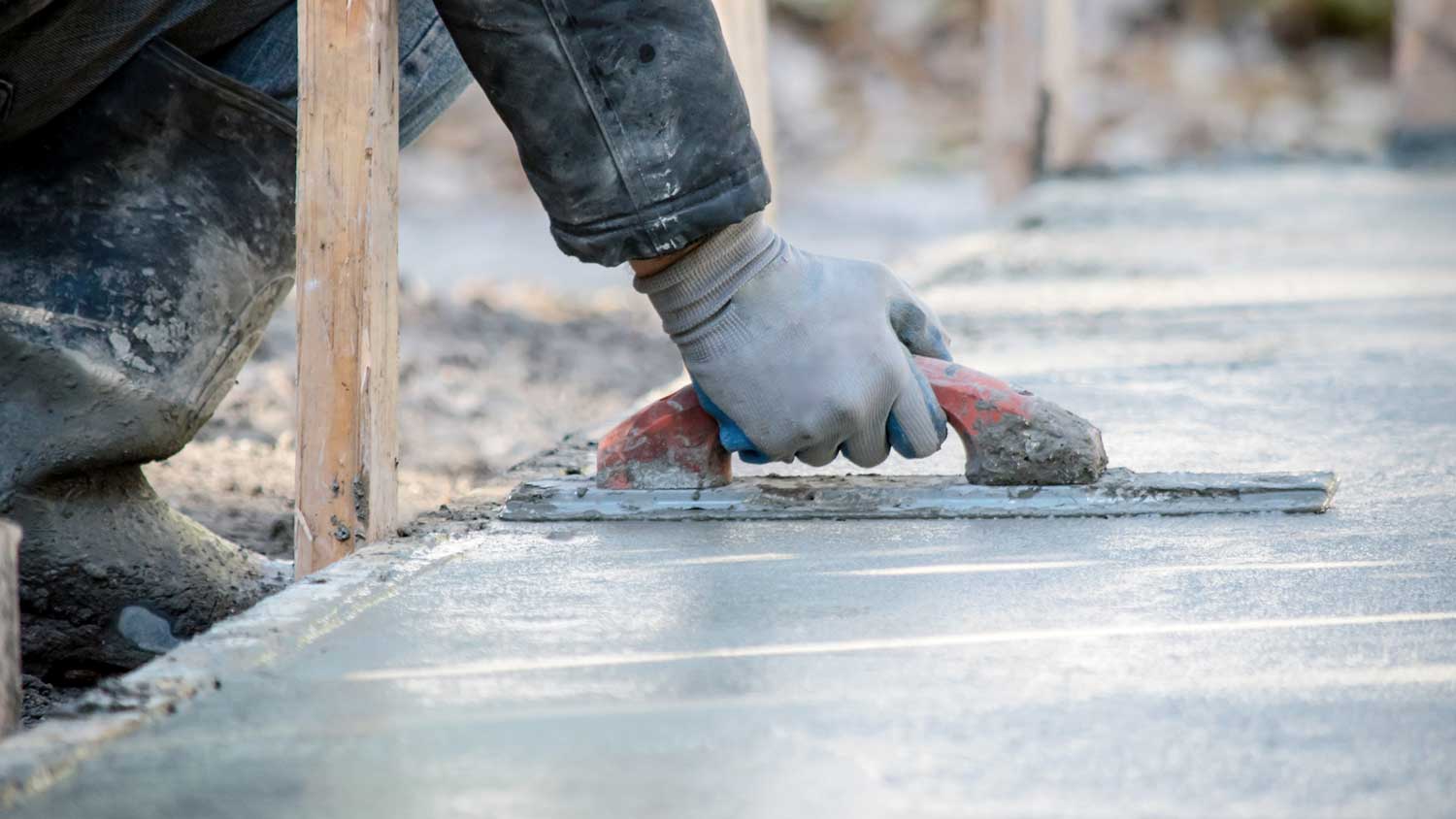10 Things to Know Before Pouring Concrete in Cold Weather
You don’t need to wait for summer to start that concrete project


Whether it’s a new foundation or a driveway, a planned project or emergency repairs, sometimes you need to learn to work with concrete in the cold. The good news is that pouring concrete in cold weather is not off the table, and there’s no need to wait for warmer temperatures to do concrete work as long as you know how. Follow these 10 tips before you start that concrete project in the wintertime.

Can You Pour Concrete in the Winter?
Winter is not the best time to pour concrete, but you can get the job done in the cold. In fact, with the right materials and information, you can not only get your concrete project completed in cold weather but also end up with a stronger slab.
According to the American Concrete Institute, an international authority on concrete best practices, special techniques are required when pouring concrete in cold weather, specifically temperatures below 50 degrees Fahrenheit. But there is an upside. When done correctly, concrete poured in cool weather can be stronger than concrete poured in hot weather because of the slower curing time.
Keep the weather in mind when pouring concrete. If it's too hot or cold outside, it can make the process more difficult. Try to pour concrete in 50 to 60 degree weather.
1. Watch the Weather
Pouring concrete in cold weather is possible and sometimes even preferred, but wait for warmer weather if temperatures have been or are expected to be too cold, especially if you’re pouring concrete in the rain. Aim for temperatures above 40 degrees Fahrenheit, and never pour concrete below 20 degrees Fahrenheit unless you’re an expert with experience in cold-weather concrete work. It can be nearly impossible to keep materials warm enough for proper curing in extreme cold. If the liquid concrete freezes before it cures, you risk permanently damaging and weakening the slab.
2. Prioritize Worker Safety
People always come first. When working in cold weather, it’s imperative to take care of yourself and the crews pouring the concrete. Make sure to use these safety tips:
Use warm clothes, heaters, warming stations, and regular breaks.
Know the signs of frostbite and hypothermia, and have a plan for staying and getting warm.
If you’re hiring a concrete flooring company near you to do the work, ask about their cold-weather contingency plans for employees and the job. Hiring the best concrete contractor can take a little research, but it's worth the work in the end.
Understand that cold temperatures can mean longer cure times, which can mean longer timelines for job completion, higher labor costs, and increased concrete slab cost.
3. Get the Site Ready
Never pour concrete on frozen ground, ice, or snow. Instead, assess air and ground temperatures and warm the ground by covering it with blankets or black plastic for a few days before the concrete work begins. If conditions are expected to be windy or evolving, consider constructing windbreaks to protect the site from wind and temperature changes. Very cold conditions may require protective enclosures and heaters. And remember to warm tools and forms. Cold forms and tools can cool the concrete too quickly, so store them inside or warm them up before use.
4. Choose the Right Concrete and Pour Method
It’s very important to use concrete that’s compatible with cool-weather pouring. You’ll want to choose a strong type of concrete that has a compressive strength rating of at least 4,000 pounds per square inch or 27 megapascals. You can also look for air-entrained concrete that allows water into tiny voids, which relieves pressure during freezing and expansion.
If you’re hiring a concrete contractor, verify that they’re using concrete recommended for cold weather, and have them put the specifics in writing in your contract.
When it comes to whether you should dry pour or wet pour concrete, remember that dry pouring will almost always result in a weaker slab because you don’t guarantee the right ratio of water to cement or even mixing. Dry pouring is much more likely to lead to weaker slabs, and since pouring concrete in cold weather also increases the risk of weak concrete, you should avoid dry pouring in the cold at all costs.
5. Consider Using Accelerants

Curing times are longer when pouring concrete in cold weather, but the faster the concrete sets, the less likely it is to fail due to cold weather damage. To make concrete cure faster in cold weather, you can consider using accelerants, also called accelerating chemical admixtures, and water reducers.
You can also adjust the concrete mixture to perform better in cold temperatures. Adding more cement can bring the mix to optimal hydration levels and add more heat to the curing process, which can make curing go faster and result in stronger concrete that resists cracking, chipping, and concrete spalling.
6. Prepare the Concrete
Preheating the water and aggregate mix to between 140 and 180 degrees Fahrenheit is a smart way to get the right pouring temperature. Transporting ready-mixed concrete in warmed trucks and keeping concrete that’s mixed on-site in a warm location are also smart moves. Then, pour it as soon as you can so it’s as warm as possible when placed, and be ready to keep it warm while it sets.
7. Track the Temperature
During curing, use an infrared temperature gun to monitor temperatures. Concrete should ideally stay above 50 degrees Fahrenheit and shouldn’t fall below 40 degrees Fahrenheit during curing, and it should never be allowed to freeze during the first 24 hours after pouring.
If you’re pouring in an enclosed area, use heaters or insulating blankets to keep the concrete warm as it dries. It’s smart to keep a log of air and concrete temperatures during cooling so you can anticipate trends. Even if you don’t think you’ll need them, have blankets, lights, and heating options ready in case the temperature drops too quickly.
8. Be Patient

Don’t rush the curing process. All the bleed water should evaporate before the finishing process begins. Because cold-weather curing takes more time, the bleed process will begin later and take longer than usual, and more water may bleed from the concrete. This process takes even longer when pouring concrete in the rain, so give it all the time it needs based on conditions.
9. Let It Set
Keep concrete forming equipment in place as long as possible when pouring concrete in cold weather. Forms help retain heat and prevent the concrete from drying too quickly. In very cool conditions, consider using heated forms or pumping steam in the pour area. Because concrete poured and set in cold weather cures more slowly than concrete poured in warm weather, plan to give it several days to a few weeks for gradual curing, depending on the temperature and size of the job, to prevent cracking or other common issues such as concrete popouts.
10. Apply Concrete Sealant
Once the concrete has cured completely, apply a sealant to keep water from seeping back in. If you’re in an extremely cold area, choose a breathable sealant so water can evaporate from the concrete slab. The cost to seal concrete and recommended sealants depend on the job.
Frequently Asked Questions
It’s possible to pour concrete if the temperatures are expected to dip below freezing at night, but you need to take some special precautions before you do. Most importantly, you need to make sure your concrete won’t freeze, so the best thing to do is enclose the area and heat it. You should also make sure you’re using cold-weather concrete that’s designed for pouring in cold weather. Use accelerants to help speed up the curing process and avoid cold temperatures from resulting in weak concrete.
Concrete can cure in 24 hours if the temperature remains above 40 degrees, but it might take up to 48 hours for the initial curing if the temperature drops close to freezing. You can speed up the curing process in cold weather by using accelerants, or you can insulate the slab or enclose and warm the area with heaters.
Insulating under a concrete slab foundation is a great way to improve the energy efficiency of your home, but it isn't necessary for outdoor projects like driveways, patios, sidewalks, and walkways. If you’re pouring in cold weather, insulating under the slab can help prevent heat loss from the concrete, aiding in proper curing. Along with accelerants, this can be a good way to ensure strong concrete despite pouring in the cold.





- Things to Know Before Pouring Concrete in the Rain
- Can You Pour New Concrete Over Existing Concrete?
- 7 Tips to Prevent Concrete From Cracking
- 9 Tips and Tricks for Beginners Working With Concrete
- How Long Before You Can Drive on a New Concrete Driveway?
- 6 Concrete Maintenance Tips to Extend Its Longevity
- 17 Types of Concrete and How They’re Used
- Unlocking the Advantages of Concrete: Why It’s the Ultimate Building Material
- How to Dispose of Concrete 5 Ways
- How to Clean Concrete Indoors and Outdoors











